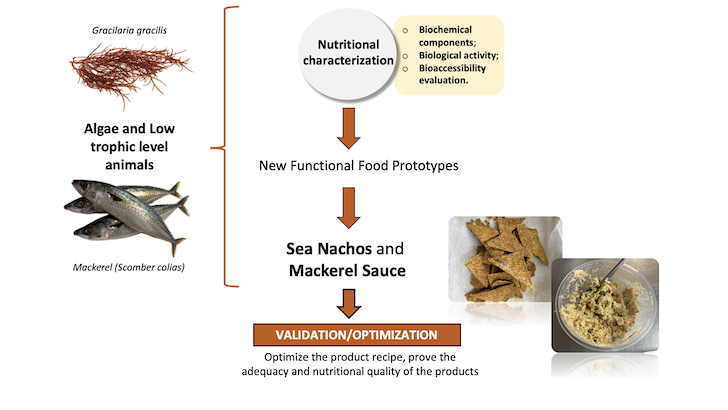Development of innovative food products from by-products and bycatch
The global food shortage and changes in dietary patterns have led to a search of new sources of healthy, nutritious, and sustainable food. Undervalued marine resources can play an important role in these new diets, such as algae and by-catch fish species. They are a valuable source of essential elements such as selenium and iodine, omega-3 polyunsaturated fatty acids, as EPA (eicosapentaenoic acid) and DHA (docosahexaenoic acid), vitamins, proteins, polyphenols, among other bioactive substances with important biological activities (e.g., antioxidant and anti-inflammatory). These compounds are essential for maintaining life, bringing benefits in neuro-cognitive and visual development, reducing the risk of cardiovascular disease and stroke, as well as preventing other diseases such as cancer and diabetes. Furthermore, functional foods/ingredients are becoming increasingly important at a global level and the development of new food products incorporating under-exploited marine resources has a huge untapped potential.
Functional foods/ingredients are those which, due to their nutritional properties and based on scientific evidence, provide additional health benefits. The formulation of foods enriched with functional ingredients is based on legislated nutritional and health claims with scientific evidence that these compounds have benefits for cognitive health.
The aim of IPMA DivAV AQUAFISH0.0 is to meet the challenge of enhancing and innovating towards healthy food for the future based on under-exploited marine resources (and by-products). Thus, DivAV carried out the production of two different new functional food product prototypes, taking by-products and bycatch as raw material: the red seaweed Gracilaria gracilis, and mackerel Scomber colias, a low trophic level animal. This trial is part of the task 1.3 (Pilot actions: Search for sustainable productive models and creation of innovative food products).
Two different trials were carried out:
- Development of the new potential functional food products: Sea Nachos and Mackerel Sauce;
- Performance of analyses that explore various possible functional ingredients and prove the adequacy and nutritional quality of the products, on the basis of a physicochemical-sensory assessment (biochemical components, biological activity, etc.) and bioaccessibility evaluation, being culinary treatment/processing also considered.

The incorporation of seaweed and mackerel into the formulated product made it possible to develop an affordable, sustainable, and healthy product, allowing its consumption to add benefits beyond the usual nutritional ones.
Hopefully, the successful innovation brought about by such novel foods will provide an inspiration and template for future projects and the seafood industry in the conception and development of a new generation of high value-added products.
For more information:
Pacheco D, Matos J, Afonso C, Cardoso C. 2025. Application of wet route extraction and its potential for attaining biologically active compounds from seaweed biomass: The case‑study of Gracilaria gracilis. Journal of Applied Phycology, in press. https://doi.org/10.1007/s10811-025-03529-6
Matos J, Cardoso C, Serralheiro ML, Bandarra NB, Afonso C. 2024. Seaweed bioactives potential as nutraceuticals and functional ingredients: A review. Journal of Food Composition and Analysis, 133. https://doi.org/10.1016/j.jfca.2024.106453
Cardoso C, Valentim J, Gomes R, Matos J, Rego A, Coelho I, Delgado I, Motta C, Castanheira I, Prates JAM, Bandarra NM, Afonso C. 2024. Mackerel and Seaweed Burger as a Functional Product for Brain and Cognitive Aging Prevention. Foods, 13, 1332. https://doi.org/10.3390/foods13091332
Others:
Valentim J, Afonso C, Gomes R, Gomes-Bispo A, Prates J, Bandarra NM, Cardoso C. 2024. Influence of cooking methods and storage time on colour, texture, and fatty acid profile of a novel fish burger for the prevention of cognitive decline. Heliyon 10, e27171. https://doi.org/10.1016/j.heliyon.2024.e27171
Afonso C, Cardoso C, Gomes-Bispo A, Ferreira I, Rego A, Coelho I, Motta C, Prates JAM, Castanheira I, Bandarra NM. 2023. Fatty acids, selenium, and vitamin B12 in chub mackerel (Scomber colias) as nourishment considering seasonality and bioaccessibility as factors. Food Chemistry, 403, 134455. https://doi.org/10.1016/j.foodchem.2022.134455
Ferreira I, Gomes-Bispo A, Lourenço H, Matos J, Afonso C, Cardoso C, Castanheira I, Motta C, Prates JAM, Bandarra NM. 2020. The chemical composition and lipid profile of the chub mackerel (Scomber colias) show a strong seasonal dependence: Contribution to a nutritional evaluation. Biochimie, 178: 181-189. https://doi.org/10.1016/j.biochi.2020.09.022
AQUAFISH 0.0 is a project funded by ERDF through the INTERREG Atlantic Area 2021-2027 programme (project code EAPA_0062/2022).

